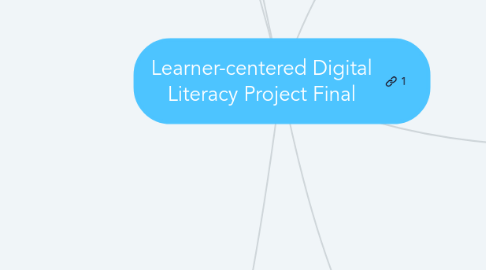
1. Must Be
1.1. Learner Centered
1.2. Interactive
1.3. Focused on digital literacy/digital media
1.4. Pick two (Act, access, analyze, reflect, create) see: Digital and Media Literacy: How Can It Support 21st Century Learning?
1.4.1. Create: "composing or generating content using creativity and confidence in self-expression, with awareness of purpose, audience, and composition techniques into the world of digital and media.”
1.4.1.1. Encourage students to think about their media's purpose and target audience.
1.4.1.2. Maybe give examples of composition techniques in a google doc they can view but not edit.
1.4.2. ACT: The fifth and final step or competency is “working individually or collaboratively to share knowledge and solve problems in the family, the workplace, and the community.” It means participating in local and global communities. According to Hobbs, this step involves getting students in the classroom connected to the world, providing support for their leadership development and collaboration, and developing integrity and accountability as they take their place as global citizens. Students need to engage in using digital and media in solving problems and at the same time take advantage of global connectivity. Because the 21st century world is a much smaller place, our students need to be able to "act" using their digital and media skills.
1.4.2.1. As media interns: yes, they need to do their own work. However, the goal of all the "interns" is to get their person elected. So while this is NOT a group project, students are welcome to help each other and are encouraged to do so.
1.4.2.1.1. Helping does not mean it's ok for them to plagiarize your work.
1.4.2.2. Their media should share knowledge and solve/address problems in America/the world
1.5. Learners must CREATE
2. Resources
3. Ideas
3.1. Could be used as a PBA for next year
3.2. Students given the role of "Media Intern" for a political party of their choice.
3.2.1. Can choose/make up their own party if they don't like Dem/Rep. Can create their own party centered around a candidate of their choice. (Must be alive and non-fictional)(Beyonce= yes, Cookie Monster= no)
3.2.2. Must create an ad campaign of their choice
3.2.3. for students who lack creativity, list suggestions: 5 campaign posters, 1 video ad, 1 informational pamphlet, social media campaign, or slide presentation the candidate could use during their next speech/rally
3.2.3.1. video: may be too hard/ time intensive for most students. They wouldn't know how to go about this except to write a script and record it. No video editing skills. Not enough time in the semester to teach video editing properly. (especially since most will choose an easier creation)
3.2.3.2. SOCIAL MEDIA PRESENCE!!! My kids love instagram.
3.2.3.2.1. they would not create an actual account.
3.2.3.2.2. Instagram: create 5 "posts" centered around your chosen candidate. use these posts to convince me of why they should be President. Can select/edit photos from the internet, but must cite source at the end of each post. Submitted via a google doc or google slide.
3.2.3.2.3. Twitter: create 5 posts with appropriate hashtags. Must be well thought out. "vote for me" is really not that convincing.
3.2.3.3. Rules against Laziness: "yard signs" (the ones that are just the name and vote for me) cannot be your only idea. Be better.
3.2.4. overarching goal= CONVINCE ME! create a media campaign that makes me want to vote for your person
3.2.5. "interns" with the best ideas get "hired"
3.2.5.1. What does that mean? "Cash" reward?
3.2.5.2. Bribery? Incentive? Or real-world connection?
3.2.5.3. Or it just means you passed
3.2.6. IEP Possible Accommodations
3.2.6.1. 3 posters instead of 5 (One can be a "vote for me")
3.2.6.2. Could focus on creating relevant memes
3.2.6.3. Complete work in a small-group setting with input from teacher and special-educator
3.2.6.4. Posters should still be digital, created using google drawing
3.3. Students given the role of journalist for a news outlet.
3.3.1. must consider the sources and bias when writing their article/script
3.3.2. create a short article or script for a broadcast news station concerning a hot topic for this election (emphasize selected issue)
3.3.2.1. what is the issue
3.3.2.2. what are both sides of the issue
3.3.2.3. has either candidate responded to/taken a position on this issue yet?
3.3.2.4. what, in your opinion, should be done to address this issue?
3.3.3. what technology would they use to create stuff?
3.3.3.1. Google suite. Is that enough?
3.3.3.2. Make a recording of their broadcast using screencastomatic. or we could go to the library and record there.
3.3.3.3. Find an online template for typical news website look.
3.3.3.3.1. ooooo, they could even put in what they think the ads on the side would be. Not relevant, but a fun extra detail.
4. Standards
4.1. CE State Standards
4.1.1. Unit 2: Elections
4.1.1.1. Role of the Media CE 5.c
4.1.1.1.1. identify candidates
4.1.1.1.2. emphasize selected issues
4.1.1.1.3. publish editorials, op-ed pieces, political cartoons, post to social media and blogs
4.1.1.1.4. broadcast different points of view
4.1.1.2. How government uses media
4.1.1.2.1. communicate to public
4.1.1.3. How political parties use media
4.1.1.3.1. educate the electorate
4.1.1.3.2. help persuade people
4.1.1.3.3. target political center
4.1.1.4. Evaluating media CE 5.c
4.1.1.4.1. Bias
4.1.1.4.2. fact/opinion
4.1.1.4.3. sources
4.1.1.4.4. propaganda

